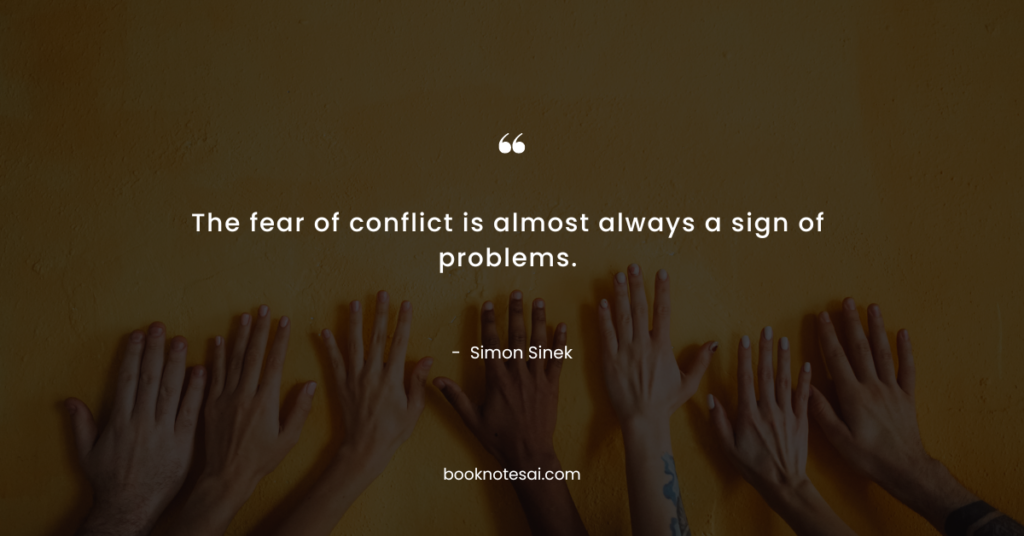Listen To This Post
The Five Dysfunctions of a Team Summary: A Leadership Fable.
The New York Times best-selling team leadership handbook for modern executives, managers, and organizations.

This is a book summary for The Five Dysfunctions of a Team by Simon Sinek. The essential information is structured to be straightforward, useful, and valuable, all while helping you save plenty of time.
Introduction: Why this book?
- In The Five Dysfunctions of a Team by Simon Sinek, you’ll uncover profound insights into building strong, cohesive teams.
- By investing your time in understanding the principles outlined in this book, you equip yourself with the tools to foster teamwork, collaboration, and success.
The Five Dysfunctions of a Team Summary:
- In The Five Dysfunctions of a Team, Simon Sinek presents a powerful leadership fable that delves into the core issues hindering team effectiveness.
- Through a narrative centered around a struggling executive team, Sinek unveils the five dysfunctions – absence of trust, fear of conflict, lack of commitment, avoidance of accountability, and inattention to results.
- By addressing these dysfunctions, teams can cultivate trust, engage in healthy conflict, commit to decisions, hold one another accountable, and focus on collective outcomes.
- Sinek emphasizes the importance of vulnerability, open communication, and shared goals in fostering a culture of collaboration and high performance.
- Ultimately, the book serves as a roadmap for leaders striving to build resilient teams capable of achieving extraordinary results.
💡 5 Big Ideas
- Building Trust:
Trust forms the foundation of effective teamwork. Sinek underscores the significance of vulnerability and authenticity in fostering trust among team members.
By cultivating an environment where individuals feel safe to express themselves, teams can establish trust and strengthen relationships, thereby enhancing collaboration and productivity. - Embracing Conflict:
Healthy conflict is essential for driving innovation and fostering robust decision-making processes. Sinek advocates for embracing constructive conflict as a means of surfacing diverse perspectives and challenging conventional thinking.
By encouraging open dialogue and respectful disagreement, teams can harness conflict as a catalyst for growth and innovation. - Fostering Commitment:
Commitment is the result of clarity, alignment, and buy-in. Sinek highlights the importance of setting clear expectations, aligning goals, and securing collective commitment to decisions.
By fostering a culture of accountability and shared purpose, teams can drive alignment and ensure progress towards common objectives. - Accountability and Responsibility:
Accountability entails holding oneself and others answerable for commitments and outcomes. Sinek emphasizes the role of individual and collective accountability in driving performance and achieving results.
By promoting a culture of ownership and responsibility, teams can instill a sense of urgency and drive continuous improvement. - Prioritizing Results:
Collective success hinges on prioritizing team goals over individual interests. Sinek underscores the importance of focusing on collective outcomes and celebrating shared achievements.
By aligning efforts towards common objectives and measuring progress against key results, teams can sustain momentum and drive sustainable success.
In summary, The Five Dysfunctions of a Team illuminates the critical components of effective teamwork, offering practical strategies for overcoming common challenges and achieving peak performance.
Powerful Quotes
- “Trust is knowing that when a team member does push you, they’re doing it because they care about the team.”
This quote emphasizes the importance of trust in fostering a supportive team environment. - “Great teams do not hold back with one another. They are unafraid to air their dirty laundry.”
This quote highlights the value of open communication and constructive conflict within teams. - “Not finance. Not strategy. Not technology. It is teamwork that remains the ultimate competitive advantage, both because it is so powerful and so rare.”
This quote underscores the transformative power of teamwork in driving organizational success. - “If you could get all the people in an organization rowing in the same direction, you could dominate any industry, in any market, against any competition, at any time.”
This quote emphasizes the collective strength and competitive advantage of aligned teams. - “Remember teamwork begins by building trust. And the only way to do that is to overcome our need for invulnerability.”
This quote highlights the foundational role of trust in fostering effective teamwork. - “Achieving results is the overarching goal of any team, but the individual needs to be secondary to the team.”
This quote emphasizes the importance of prioritizing collective outcomes over individual interests. - “The greatest barrier to teamwork is the fear of being vulnerable, the fear of conflict, and the fear of being wrong.”
This quote addresses common barriers to effective teamwork and collaboration. - “If you could get all the people in an organization rowing in the same direction, you could dominate any industry, in any market, against any competition, at any time.”
This quote underscores the transformative power of aligned teams in driving organizational success. - “The fear of conflict is almost always a sign of problems.”
This quote highlights the importance of addressing conflict constructively to foster team cohesion and growth. - “Remember, teamwork begins by building trust. And the only way to do that is to overcome our need for invulnerability.”
This quote underscores the foundational role of trust in building strong, cohesive teams.
One Reason To Read This Book:
You should read The Five Dysfunctions of a Team to unlock the secrets of building cohesive teams and driving extraordinary results through trust, collaboration, and shared accountability.
Who should I recommend The Five Dysfunctions of a Team Summary to?
This summary is ideal for leaders, managers, and team members across industries seeking to enhance teamwork, communication, and performance.
Whether you’re a seasoned executive or a new team member, the insights presented in this summary offer actionable strategies for fostering collaboration and achieving collective success.
Recommendations:
- Article: “The Importance of Psychological Safety in Teams” – Harvard Business Review
- Podcast: “Building High-Performing Teams” – TED Talks Daily
- Book: “Leaders Eat Last: Why Some Teams Pull Together and Others Don’t” by Simon Sinek
The summary provided here offers a glimpse into the discussed title The Five Dysfunctions of a Team, providing valuable insights. For a richer understanding, we recommend delving into the full book.


